DreamWorks Animation (November 7 2008), DreamWorks/Paramount Home Entertainment (February 6 2009), single disc, 89 mins plus supplements, 1080p high-definition 1.78:1, Dolby Digital 5.1 True-HD, Rated PG, Retail: $39.99
Storyboard:
The fugitive animals of the New York Public Zoo and those darned surveillance loving penguins are back in a rather convoluted continuation of the Madagascar franchise.
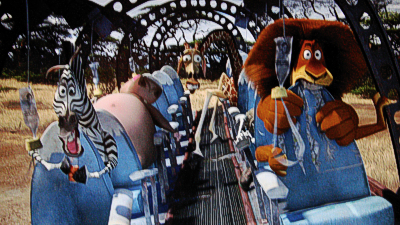
The Sweatbox Review:
With Alex, Melman, Gloria, Marty and those Penguins making a smash-hit return to the big screen in Escape To Africa, DreamWorks’ Madagascar becomes the Studio’s second most important franchise, behind the increasingly tired Shreks and the next title from their catalog to be endlessly and needlessly sequalized, Kung Fu Panda. DreamWorks films fall into two definite camps: the ones that seek to entertain all ages and are not afraid to stretch themselves one way or another, and the ones that are just content to be loud, noisy, messy crowd pleasers; the commercial endeavors that appeal to wide audiences. While it would be easy to place Madagascar: Escape2 Africa within that latter bunch, the truth is that it straddles both arenas, perhaps more noisy than most, but adding a touch of surprising emotion that actually resonates.
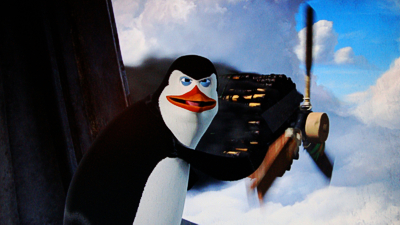
It’s a much, much better film than its predecessor for these reasons, even if it remains derivative of other projects and, indeed, the popular elements from the first film. With DreamWorks ever eager to please, they’ve thrown out any true artistic ambitions and simply gone for what they know works. In a film that screams more than any other in recent times of listening and giving the audience what they want, Escape isn’t really anything more than a re-packaging of the memorable bits audiences came away with from the first time around. Forget the main characters: this is more about giving us more. More penguins, more King Julien, more Nana, the old karate-chopping lady who amusingly but predictably beat up Alex on the New York subway.
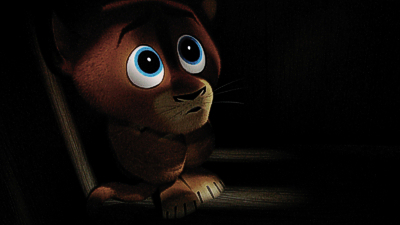
As such Madagascar 2 is often in danger of feeling like “more of the same”, and it would be nothing more than that if not for the fact that it does have some new tricks up its sleeve. One of these, simultaneously also illustrating the problems the film does have, comes right at the opening, set in Africa and revealing Alex the lion’s backstory. Born in the wild, this pre-credit sequence fills us in on where he came from and how he winds up boxed in a crate bound for the New York Public Zoo, where we met him from the first film. With that story established, and the animals seemingly back in the Zoo, the credits montage begins, expediting their journey from the original and getting them back to the wilds of Africa…well, Madagascar, which is in Africa to begin with, where we left them at the end of part one and where our “new” story actually begins.
While the opening is more heartfelt than anything in Madagascar, the throwing back and forth between Alex’s past, zapping forward to his Zoo days, an then whisking us back to Africa again, is all just too all over the place, not only suggesting that this has been thrown together only because the first was such an unexpected hit and that the filmmakers never had a plan for a sequel (or the now announced third film), but also contradicting at least a couple of points seemingly established previously. Not that I paid much attention first time out: I found the original Madagascar to be on that loud and noisy list, and despite the media attention between it and another film released around the same time, I actually found The Wild to be a much warmer take on a similar theme.

So if only for that reason, Madagascar: Escape 2 Africa (a silly name since the animals are already in Africa; the original The Crate Escape was an infinitely more entertaining title) works as a better film that its inspiration. Much of this is down to the late Bernie Mac, a comedian I wasn’t too fond of but did enjoy sporadically in a lot of his more usual fare, but who here really pushes the boat out in terms of delivering a full rounded and very generous performance. He’s Alex’s Dad, who only wants for his son to grow to be the leader of his group, but has a rival in the shape of his twisted brother, voiced by Alec Baldwin. In a complete opposite to Mac’s vocals, Baldwin – usually an actor who brings a definitive personality to his roles – is as bland as they come, and when I first saw the picture in a theater I spent most of the film trying to work out whose voice I was hearing. The sub-Lion King shifty uncle plot doesn’t really detract that things are less original than they might be, either.
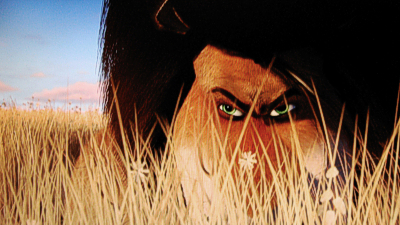
But there is a decent enough film in here trying to get out, even if the various other elements conspire against that happening. Once “back” in Africa, Alex naturally comes across his parents again, the ageing Dad proud to put his boy forward to claim his birthright. While all that is going on, those rascally penguins continue their plans to try and get everyone back to New York, including lemur King Julien who inexplicably comes along for the ride for no other reason than to make sure the audience gets what it came for and for the characters to sing I Like To Move It, Move It a few more times. Also back, and shoehorned in like no other fish out of water character I’ve yet come across, is the apparently named “Nana”, who just so happens to be out on safari in the same neck of the jungle as where our story is taking place. Imagine that! No, imagine the DreamWorks feedback meeting instead: “hey, the audience loved that old lady, let’s shove her in any old how!”
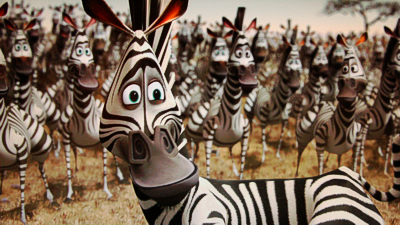
So I’m maybe being way to harsh here on what is ostensibly nothing more than an attempt to make a laugh out loud animated comedy. On that count, and as a crowd pleaser, Mad 2 delivers, if only because this is like a bloated calorific meal where all the greens have been taken out and what we get left is the deep fried stuff and a candy stuffed desert. Yes, there’s more of an emotional subtext here and there (apart from Alex, the others find themselves and family too) but rather than help ground the film it splits it in two, or three if you’re counting the Lion King uncle plot, which injects a bit of excitement but feels borrowed wholesale from another movie. It’s with all these extra plotlines and characters that Madagascar: Escape 2 Africa loses its way multiple times, falling into the sequel trap of wanting to give us more of the same but trying to add “more” to the more.
As such, the film is continuously flitting between characters, whose plots don’t help matters by being mostly fragmented, meaning that the core group aren’t actually together for very long throughout the movie, adding yet another episodic nature to things. In just basically playing like a shopping list of popular situations from the first film, or a showcase for the old characters to just pop up and do something funny before the next scene arrives, Mad 2 feels like it’s almost been made by the audience: a throw it all into a hat and pull out each scene randomly. Making a film like that won’t exactly put something together that’s too coherent, and that’s certainly the end result: is Escape 2 Africa about identity? Coming of age? Responsibility? Perhaps the current CG-toon favorite the environment? Nepotism? It never can make up its mind and is never very clear.
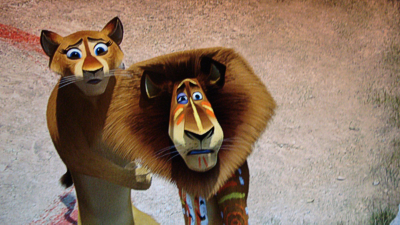
On the plus side, the wide African panoramas are stunningly rendered in DreamWorks’ state of the art CG, and the character animation shows the development the Studio’s artists have made over the past few years. If nothing else, switch off the sound (or your brain) and just let the sharply defined and colorful vistas sweep over your eyeballs. The cast give it their all too, and I probably warmed to them all a bit more this time around, even Ben Stiller’s Alex, despite some lazy writing (the film being satisfied for Stiller to simply reprise his bolshy “what? how? why? me?” act and settling for a repeat of his “you wanna piece of that!?” line again instead of giving his character any of his own dynamics). Likewise, Sacha Baron Cohen’s Julien, an unpopular (with me) “scene-stealer” in the first film who gets a bigger part here, actually emerges as one of the better things in the movie, with a very funny conclusion to his plot that would be hilarious if the volcanic mountain depicted during these moments hadn’t actually been extinct for thousands of years.
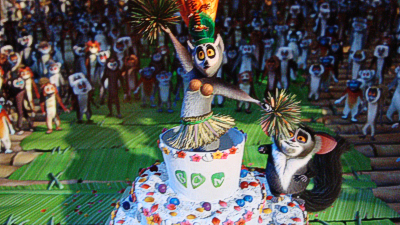
We should have been clued in from the title and its giant faux pas that Madagascar is part of Africa, and where they actually end up (escaping from one part of the continent to another) is Kenya, but with all the money the film made, and a “trilogy closing” third part (let’s hope), I shouldn’t think this matters very much. I was left wondering what the world is coming to when such commercially minded yuck as this can go out and make so much moolah: it was as if the DreamWorks committee had actually skipped a second film and delivered us the Shrek The Third of Madagascar movies. The story issues are not helped by having to start the movie hopping between Africa/Kenya and back in New York, replaying the first movie plot in seven seconds, and then just throwing any amount of crowd-pleasing jokes and loud music at the screen and seeing what sticks.
However, in trying to add, add, add to the first outing, it’s made this second one too overbearing. It has its moments, but coming after the genius of Kung Fu Panda one perhaps hoped for something that would give us “more Madagascar” but with more deeper layers underneath rather than simply piling more elements on top. In the end, I found it very frustrating…a return to the more typical DreamWorks outings that forwent a strong story for an episodic plot that felt very, very forced (though I should be fair and say that the audience I was with loved it and laughed throughout). I don’t have a problem with filmmaking by numbers when it’s done well, but Mad 2 is only interested in one thing: keeping us laughing enough so that we didn’t realize how bad it all is.
Is This Thing Loaded?
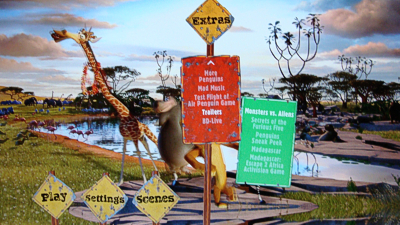
Skipping the DVD double pack conundrum that was Kung Fu Panda, in which the consumer had to pick between a two-disc standard definition bundle that included a bonus short and a Blu-ray Disc that didn’t, Madagascar: Escape 2 Africa plays fair by including all the content on both editions. With that in mind, there isn’t really a lot of different between the extras, save for a couple of extra sprinkles and the majority of them arriving on Blu-ray in high-def format. As the disc plays, previews for upcoming DWs product flashes by, including a new and much more inviting trailer for Monsters Vs. Aliens that suggests that, while DWs is continuing down the audience-friendly route as opposed to the more Panda-orientated cleverness, this could be a lot of ridiculous fun. Other previews include the stand-alone Secrets Of The Furious Five DVD, the television debut of The Penguins Of Madagascar (shouldn’t that be The Madagascar Penguins?) and the original Madagascar and a game trailer available from its own menu option.
This being a Blu-ray Disc, the menu options (or most of them anyway) are available while the movie plays in the background, but there is a main menu – which loops an insanity driving dance animation and the Move It song over and over – itself that offers up more options, including the wealth of the supplements. Chief of these is the Filmmakers’ Commentary coupled on the BD with an Animator’s Corner. Both of these tracks employ the same audio: on the DVD, you’ll simply hear a good, solid audio commentary with the producers and directors, but on the Blu-ray this is accompanied by a picture-in-picture addition that displays assorted lots of storyboard art, concept drawings and animators at work at their PCs. This is the first such track I’ve actually covered for review, but I’ve seen similar on the Disney BDs and have to say the Mouse has the upper hand: whereas those discs brim along with added picture info popping up from time to time, here the emphasis is on the Animator’s Corner, which essentially presents the audio booth on screen for the majority of the discussion.

I’m not anti seeing the people behind the movie by any means, but staring at four folks with big headphones stuck on them for long passages of time seems like a redundant use of the technology to me. Fade ’em up and down for goodness’ sake, especially when there’s dead air. I’m not sure if this is a player issue, either, or if the limitations of the technology haven’t reached perfection, but I noticed continuously that the black areas of the PIP box did not key correctly, meaning the movie – playing underneath – could be seen in the “holes” generated by the picture information not covering the whole area. My simple desktop player not up to scratch, or a limitation of the format? Whatever it was, I wasn’t sure I liked this approach: the behind the scenes images were interesting – and would be even more so on a title I was actually fully invested in – but taking up a quarter of the screen on one shot of four people just sitting there for the most part was neither entertaining or allowed me to see enough of the movie screen underneath.
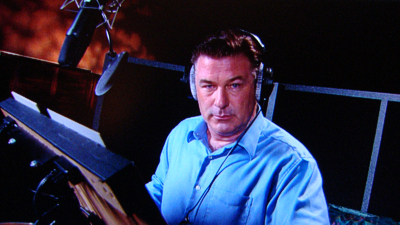
Perhaps a return to the “DVDs of old”, is a Trivia Track option that can be switched on along with the commentary, but not with the PIP corner image. This is more along the lines of what current disc users would be familiar with, though the information presented is more generally banal (“Ben Stiller was nominated for a Kid’s Choice Award for playing Alex in the original Madagascar) than usual. It’s A Family Affair: The Cast Of Escape 2 Africa (9:12) is DreamWorks’ usual peek behind the microphone to chat with the vocalists and learn how great they find working on an animated picture is. Everyone involved seems to feel that the second time around is better than the first, though a producer sums things up with the quote that everyone was happy to be doing “Madagascar again”, and Chris Rock exclaims that he can’t wait to do “the third one, and the fourth one and the fifth one”, which I’m sure will please DreamWorks, who will no doubt announce those when part three is another success.
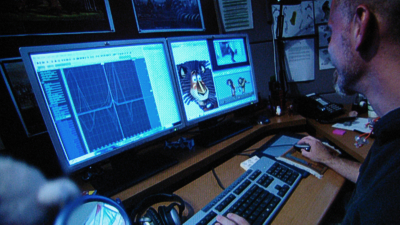
The Making Of Escape To Africa (11:05) is another decent enough featurette full of talking heads and peeks at the artists at work, with much discussion on the ambitions of a sequel and the attempts to bring a new feeling to Africa on the screen, including a location research trip captured on camera. There’s the usual speak that certain effects could never have been achieved before, but really anything is achievable nowadays and some of these comments have started to sound more and more hollow as we hear them time after time. Crash Landing (3:38) continues the theme, picking apart the movie’s plane crash moment and showing how the artists filmed the scene in live-action for reference. I didn’t quite see the point of that, but it looks like they had fun anyway.

The spirit of Kenya and the crew’s location trip is explored in African Adventure (7:17), with lots of safari footage cut in with the talking head comments on how experiencing the continent for real gave their film the right look and informed story points.
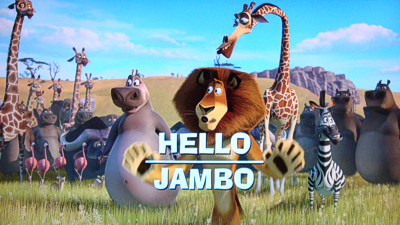
Jambo Jambo: Swahili Speak is just what you might think it is: a run-through of various words and their African translations; after a short into, the viewer can work through additional phrases. The Bronx Zoo: Madagascar (8:15) is more younger orientated filler, a tour through the Zoo’s new exhibit that actually has nothing to do with the first or second film, but does share its animals (the conservation aims are worthy too).

More Penguins is your cue to discover a couple of bonus episodes of DreamWorks Animation’s new television spin-off The Penguins Of Madagascar, animated out of house though retaining a fair amount of quality. Also available on the standard DVD two-pack of Escape 2 Africa, the two shows are presented, as with much of all this material, in HD. The show obviously ignores the movie plotlines, or at least takes place after the third, as yet unseen story’s progression, since it mostly concerns those pesky penguins and King Julien as they encounter various adventures in back at the Zoo. Both Popcorn Panic and Gone In A Flash, from their Mission: Impossible/James Bond styled openings onwards, offer yet more of the same, and I found both overlong at twelve minutes a piece. Quite how this is going to stretch to a long-running series will be down to how many one-joke penguins the audience can take, though it’s competently animated and, even if not on par with the main feature, it’s on an even keel or slightly bests the Studio’s Father Of The Pride. In addition to those two shorts, the Penguins menu option offers up four Easter Eggs, one for each penguin, that lead to four additional Julien/Penguin clips that run for around 30 seconds each in 4:3 standard definition.
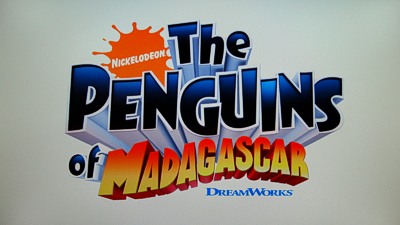
Mad Music contains a heap of “music videos”, from actually pretty decent, specially animated promos for Wili.i.am’s cover of I Like To Move It, Move It (2:48), Big And Chunky (1:05) and She Loves Me (1:22), to a Travelling Song Sing-Along (1:31), with Alex’s Dance Off (3:18) offering up a closer look at the lion’s choreography from that clip. The DreamWorks Animation Jukebox is also back and even though the clips are now presented in HD, that doesn’t make them any better and it’s still a waste of space that’s nothing more than advertising for other DWs product.

After hearing the hype that BD games were much more sophisticated than DVD’s often useless set-top efforts, I was hoping for much more from the Test Flight Of Air Penguin game, which I found to be little more than the usual fare. Again, even HD can’t make a simple, pointless game any more fun and I quickly gave up. A collection of Trailers might suggest a return of that most basic disc feature, but alas it’s just a re-run of the disc’s opening previews, while the much touted BD-Live feature hooks up to the internet to provide some extra content that can be switched and added to at later dates. Right now, at the time of the disc’s release, we’re offered The Heart Of A Lion, a standard definition live-action documentary on the real lions of the African plains that runs just twelve minutes and doesn’t seem to be streaming from the internet at all: it shows up as Title 52 on the disc.

I’ve no reason why the standard DVD-ROM features couldn’t be ported over to the Blu-ray format but the loss of those features seems to be a minor casualty as we get used to the new format. It’s a shame these can’t be incorporated into the supposedly superior technology: DreamWorks especially could always be commended for providing more than was necessary in terms of further fun in the form of printables, Flash animated games and more, which I at least always appreciated. Ahh well, there’s always the DVD two-pack, which features all those kinds of extras in lieu of the high-definition content.
Case Study:
While the DVD configurations offer the film in single disc DVD and double-pack editions (with The Penguins bonus shorts), the Blu-ray packs everything into a standard slimline BD case: shorter than a DVD and with the frankly waste of space given over to the logo branding along the top which makes the actual sleeve real estate something to lament: it’s not that larger than a Compact Disc! As such, there’s not much space to pack on synopsis, extras, credit and tech info on the back, and there’s a lot of teeny text to work through (The Penguins shorts are on the disc…if you look for them). The sleeve doesn’t use the benefit of the clear Blu case to print anything on the reverse, but an insert prompts a look at the BD-Live feature and helpfully lets us know that other DWs product is now on BD. The disc continues the trend of a plain gray silkscreen print.
Ink And Paint:
I’ve puzzled for a while now over the slight softness that one notices on a DreamWorks title as opposed to the pin sharpness of a Disney or Pixar production. Even when at its intentional haziest, the likes of WALL-E offer a multi-layered presentation that, especially on Blu-ray, one could almost step into, but DreamWorks’ films, perhaps in an attempt to give their visuals a slight glow, have always seemed softer by comparison.

I wondered if that look was intentional or not and if the clarity of Blu-ray would offer a boosting of sharpness, but it has to be said that even on this format, Mad 2 at least, doesn’t look as sharp as the few other CG films I’ve witnessed in HD. I’m still none the wiser, but one would supposed that Blu-ray offers the film exactly as intended, though it must be pointed out that the bonus Penguins shorts looked softer still (and, no, I wasn’t confusing them with the standard definition Easter Eggs).
Scratch Tracks:
Although BD can offer up to 7.1 channels of surround sound, Madagascar: Escape To Africa sticks to the 5.1 we’ve become accustomed to, though in the HD Dolby-True format. It’s a very active track, as one would expect, and there’s not much more to say about it than that! It’ll give your speaker system a workout whatever your configuration. Regular Dolby Digital dubs in French and English are also selectable, as are subtitles in all three languages.
Final Cut:
Certainly one of the lesser of DreamWorks’ all-out CG animated pictures, one can’t deny that Madagascar: Escape 2 Africa sets out to do little more than simply entertain, and pretty much does so. I only wish that we’d been given a little more meat on the bones: this is a fairly empty meal that will leave most smiling and some with a headache. This is like the too-sickly sweet desert after Kung Fu Panda’s hearty nourishment, and it’ll either leave you feeling a little unbalanced or asking for more. If that’s the case, your wish will be granted when the third and final (for now) trip to Africa (and back to New York…for good?) takes its bow in theaters. This Blu-ray hasn’t been the most impressive or user friendly to get to grips with as a first review attempt for me with the format, though one must admit that for all the hang-ups over loading time and some glitches, the image far surpasses what DVD can strive for even at the best of times.
 | ||
 |










